The Three Biggest Threats to Global Fisheries
Climate Change, Pollution, and Overfishing
Climate change, pollution, and overfishing are all taking a heavy toll on our fisheries and our planet. Climate change is affecting the ocean on many levels.
These changes influence everything from droughts and floods to marine life and ocean currents. Pollution has destroyed entire aquatic habitats and left us with giant patches of floating debris all over our oceans.
Overfishing leaves us with destroyed ecosystems, nutrient-lacking species, and a lack of biodiversity in our very sophisticated food web.
Climate Change
The ocean’s capacity for storing heat is roughly 1,000 times greater than that of our atmosphere. Thus, any changes to its circulation, temperature, and salinity can dramatically affect our weather patterns over land.
Ocean currents slowing
The Atlantic Meridional Overturning Current conveys warm water along the ocean’s surface from the tropics northward, where it is cooled, before flowing back south along the basin.
It is a major player in our weather system. A 30% reduction was observed in the AMOC between 1957 and 2004.Bryden, H.L., Longworth, H.R., Cunningham, S.A. (2005). Slowing of the Atlantic meridional overturning circulation at 25 ¨N. Nature, 438: 655–657.
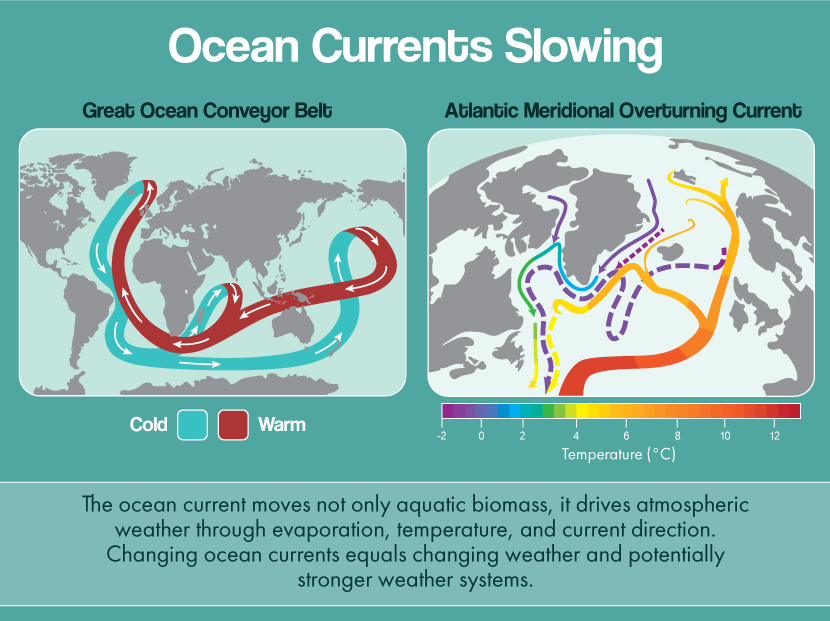
Warming Waters
- The oceans are warming, but there are some geographical differences.
- Warming is not exclusive to surface waters. The Atlantic is showing clear signs of deep warming(United Nations FAO, 2009).
Changes on Land
Chris Wood, President and CEO of Trout Unlimited (TU), told Fix.com the following:
Climate change has already begun to alter our nation’s rivers and streams. As precipitation patterns change and snow melts earlier, watersheds become drier and wild fires grow in frequency and intensity.
Peak stream flows occur earlier in the year, base flows are lower, and aquatic insects and fish change their behaviors.
Native species such as Gila and Apache trout have been profoundly affected by wildfires in recent years, and low flows can compromise Rio Grande trout where two-thirds of the remaining populations persist in streams with flows of 1 CFS or less.
Up to 50 percent of suitable wild and native trout habitat in the Intermountain West could be negatively affected by climate change by mid-century without corrective action.
One way to address the impacts of climate change is through projects that increase the resistance and resilience of rivers and streams. Restoration projects that TU undertakes to restore degraded riparian areas, reconnect fragmented streams,
and reduce stressors such as livestock grazing and invasive species help build resilience.
Our collaborative work on streams in places like California shows how this works. TU is restoring high-elevation wet meadows and riparian habitats in an effort to keep rainfall at higher elevation for longer periods and reduce the effects of less snowpack. Dam removal in places like the Elwha in Washington and the Penobscot in Maine increase resilience by expanding populations and available habitat.
We need more “adaptation” projects, not only to help our trout and salmon survive climate change but also to buy society time to find more lasting solutions.
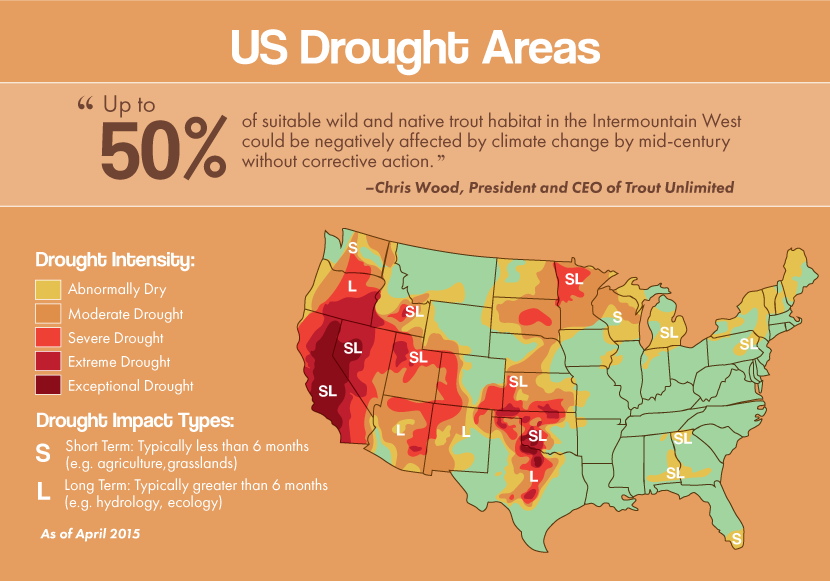
- 5°C (9°F) increase in air temperature
- 6 percent increase in precipitation
- 15 cm/6’ rise in sea level
- 5 percent increase in cloud cover
- 20-day reduction in sea ice duration
- 20 percent reduction in winter ice with substantial ice-free areas in summer
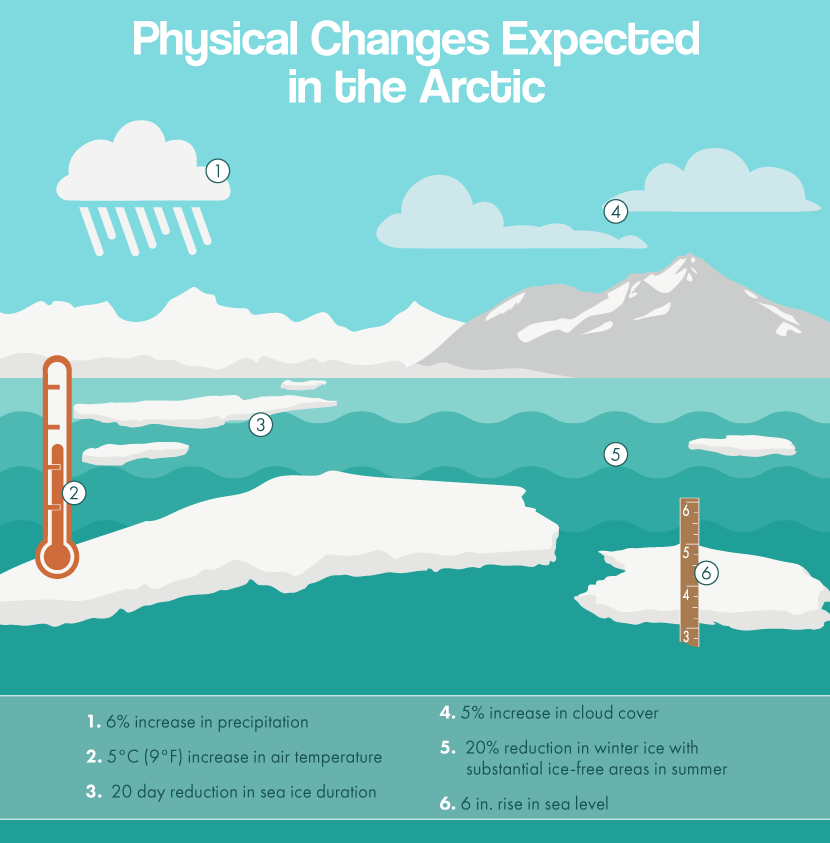
Ecological consequences in the Arctic:
- Primary production increased two to five times over present conditions
- Reduced ranges of cold-water fish and benthic species and expanded ranges of Atlantic and Pacific species northwards
- Capelin and other species with narrow temperature tolerances and late reproduction are likely to disappear from southerly habitats
- Changes to migration timing and increases in growth rates
- Non-native species are likely to increase in Arctic waters
- North Sea, Nordic seas, and Barents Sea are likely to warm by 1 to 3°C (2–5°F) over the next 50 years, with largest changes in the northernmost regions
- Increased vertical currents
- Reduced ice cover
- Populations at their range limits will be highly affected
- Glacier melt in Greenland could cause pockets of cold water that would be lethal to Atlantic cod
- Atlantic salmon may be extirpated from their present habitats
Ecological changes in the Atlantic:
- Primary production likely to increase in the Barents Sea
- Zooplankton production likely to decrease
- Northward shifts in the distributions of all species
- Fish species from south of the North Sea likely to appear in the North Sea
- Spawning areas for capelin in the Barents Sea likely to shift eastwards
- North Sea dominated by pelagic species such as herring and mackerel in the north and sardine and anchovy in the south
- Baltic Sea is predicted to become warmer and fresher; current marine species will lose their habitats to species that can tolerate low salinities
In addition to the changes in the Arctic and the Atlantic, the survival rate of cod in the Gulf of Maine will decline.
In the middle range of the Northwest Atlantic, capelin are important prey for cod, but spawning times for capelin are susceptible to delays due to cold water from melting glaciers.
Northeast Atlantic cod populations will also decline due to increasing temperatures in the North Sea.Cochrane, et al. (2009). Climate change implications for fisheries and aquaculture: overview of current scientific knowledge. FAO Fisheries and Aquaculture Technical Paper. No. 530.
Pollution: Dead Zones
Agricultural run-off, which involves the discharge of nutrients, pesticides, untreated sewage, and plastics, accounts for approximately 80 percent of all marine pollution around the world.
Excessive nutrients from untreated sewage and agricultural run-off have contributed to dead zones in which most marine life cannot survive and have already collapsed several ecosystems.
There are close to 500 dead zones so far. In all, they cover over 245,000 km² of land worldwide. If all these dead zones were in one area, their size would be roughly equivalent to that of the United Kingdom.
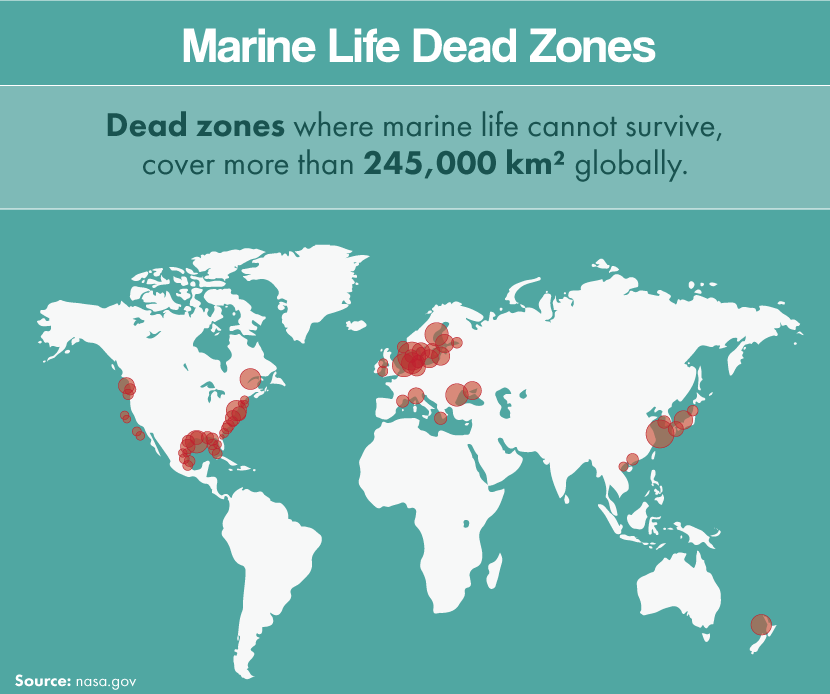
Plastics
Over 220 million tons of plastic are produced each year. Beacuse most plastics are not disposed of properly, they eventually end up in our oceans.
The United Nations Environment Program estimates that every square mile of ocean contains 46,000 pieces of floating plastic.
These discarded plastics become weathered and eroded into very small pieces known as “micro-plastics,” and they can be found on most beaches around the world.
This type of plastic debris causes the deaths of over 1,000,000 seabirds and 100,000 marine mammals each year.
Oceanic currents can concentrate plastics and other types of marine pollutants in areas known as gyres. There are now five gyres in our oceans.
The North Pacific Gyre, known as the Great Pacific Garbage Patch, occupies a relatively stationary area twice the size of Texas.
This gyre collects waste material from across the North Pacific Ocean, including the coastal waters off North America and Japan.
Overfishing
Destructive fishing practices such as bycatch are leading to the endangerment of global fisheries. Bycatch refers to all non-targeted marine species caught and destroyed by commercial fishing methods.
It is highly unregulated, and it goes unreported in most areas. It can devastate protected or commercially viable stocks.
Bottom trawling is a commercial fishing method in which a boat drags a large weighted net along the ocean floor, producing vast amounts of bycatch along the way. This method of fishing scars the ocean floor by destroying habitats, including natural coral reefs. It is estimated that 40.4 percent of all marine catch around the world is discarded back into the ocean as bycatch.DAVIES RWD, et al. (2009) Defining and estimating global marine fisheries bycatch. Marine Policy, doi:10.1016/j.marpol.2009.01.003
In the Philippines alone, it is estimated that 94.6 percent of the shrimp trawling fleet’s catch is bycatch, and only 5.4 percent of their total catch is shrimp.DAVIES RWD, et al. (2009) Defining and estimating global marine fisheries bycatch. Marine Policy, doi:10.1016/j.marpol.2009.01.003 The news is not all bad, however. A recent study from the EDF shows the potential for growth in the fisheries industry alongside the health of our oceans within 10 years, should fisheries reform introduce and legislate more sustainable practices on a global level.
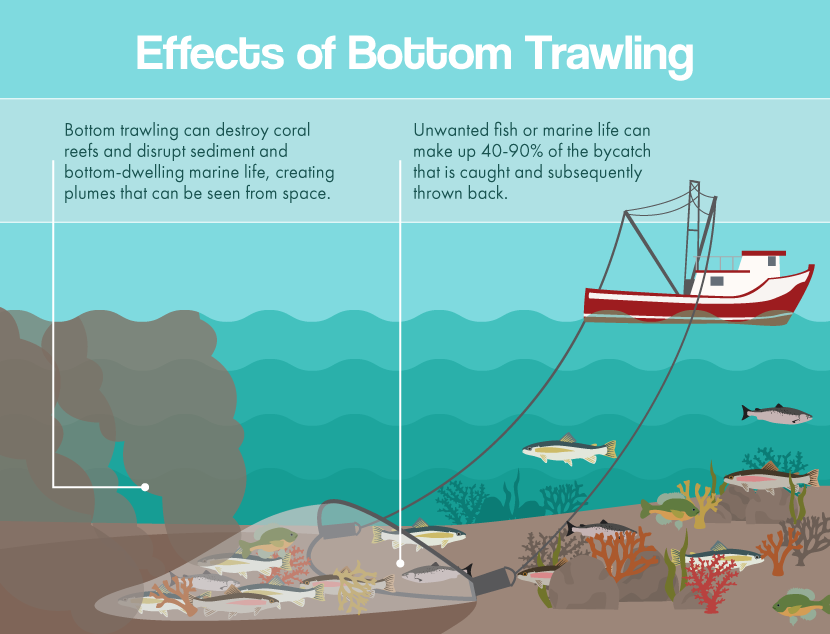
Poison
Poisoning is one of the oldest and least-known methods of fishing for sustenance. Tribal nations around the world have long used organic, plant-based ichthyotoxins and piscicides to stun fish in slow-moving water, allowing easy gathering.
In the 1950s, Pacific Island nations began using more potent, inorganic sodium cyanide to help capture coral reef species, which were sold as pets and seafood. The use of this poison quickly spread, consequently decimating fragile coral reefs.
While it may be illegal in many nations today, the practice is hard to regulate, and it still persists.Saila, S. B., Kocic, V., McManus, J. (1993). Modelling the effects of destructive fishing practices on tropical coral reefs. Marine Ecology Progress Series, 94, 51-60.
A snapshot of how overfishing has affected salmon alone paints a picture of the issue on a global level:
- Pacific salmon are now extinct in 40 percent of the rivers they historically populated in California, Oregon, Washington, and Idaho.
- Overfishing for Atlantic salmon began in the 1950s when a handful of European fishing boats discovered a patch off the coast of Greenland where the total population converges.
- The Atlantic salmon population is now around 500,000. Historically, it ranged from 10,000,000–100,000,000. Atlantic salmon were once so common that they were served to soldiers and prisoners and were used as pig feed in New England and the United Kingdom.
There’s no doubt that our environment is changing due to human impact. The degree of that change may not be certain yet, but it’s clear we’re trending in the wrong direction. This is evidenced by the effects on our oceans that have already been recorded, and those that are predicted for the future.
Embed the article on your site

